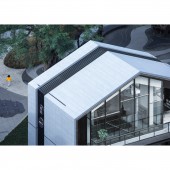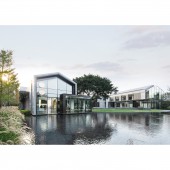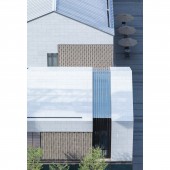Tanjing Sales Center by Shanghai PTArchitects |
Home > Winners > #116054 |
 |
|
||||
| DESIGN DETAILS | |||||
| DESIGN NAME: Tanjing PRIMARY FUNCTION: Sales Center INSPIRATION: At the beginning of the design, we had hoped to create a complex and diverse community that allowed for a wide range of cultural experiences. Through introducing business, contextual design, and open spaces into the area, we were able to connect the communities between the Minjiang River and the Guangming Port, allowing for more open correspondences both between the residents and within the city. UNIQUE PROPERTIES / PROJECT DESCRIPTION: The project is located in Taijiang District, Fuzhou City. It resides to the north of the historic Guangming Port and next to the Three Lanes and Seven Alleys Historical Area. The project preserves the two ancient banyan trees on the site, creating a series of spaces and inner streets around them and evoking the traditional Fuzhou lifestyle that exists “under the bayan tree, next to the river.” Green living, Dragon boat museum, Art exhibitions, Sales center, Leisure, and Entertainment are all united within the Tanjing Sales center, bringing a new vibrancy to the neighborhood. OPERATION / FLOW / INTERACTION: The building extends the concept of "Banyan Tree + People + Architecture" and emphasizes the interaction and harmony between nature, architecture and people. Changes in the height and scale the building are done to reveal the relationships formed by the architecture and the banyan trees. The shape and slope of the roofs are derived from the traditional buildings of Fuzhou. The gentle character inherent in these rooftops brings stability and calmness to the building. PROJECT DURATION AND LOCATION: The project started in Feb. 2019 and finished in Oct. 2019 in Fuzhou, China. FITS BEST INTO CATEGORY: Architecture, Building and Structure Design |
PRODUCTION / REALIZATION TECHNOLOGY: To match the local architecture and incorporate the ancient trees on the site, the architect uses local stone and brick as the main materials of the external wall. This further emphasizes the fusion between modern style and traditional cultural elements. These ceramic tiles are produced by local traditional techniques, and the resulting rough surface bestows a sense of time and history upon the new building. The cross-woven bricks allow the façade to breathe and create a lively atmosphere. The Tanjing project is a real estate development project with the changing modern city as its backdrop. Our deep respect for Fuzhou’s culture and our attempt to reinterpret Fuzhou’s tradition through modern means is how we, as architects, respond to our society today. Our design is an exploration and investigation of how the people of the 21st century can give back to the ancient city through developing new cultures. SPECIFICATIONS / TECHNICAL PROPERTIES: The site planning adopts Chinese courtyard layout. Accommodating the boundaries established for the preservation of ancient trees, the building is wedged into the site in a "U" shape, forming a semi-enclosed courtyard space. The two banyan trees become the center of the courtyard and the space opens as an entrance leading into the street. The relationship between the open plaza outside and the enclosed courtyard inside brings a new sense of vitality and tension to the city. TAGS: Sales center, Chinese courtyard layout, Three Lanes and Seven Alleys, Sustainability RESEARCH ABSTRACT: The project resides to the north of the historic inland waterway Guangming Port and next to the Three Lanes and Seven Alleys old town district. There are two centuries-old banyan trees and a dragon boat base inside the site. On such a landmark full of traditional humanities, the architect needs to re-examine the relationship between the natural texture and urban civilization, and to create a new urban interface in a harmonious way. CHALLENGE: The project covers a limited area, backing up to a residential area and adjacent to a main city road, also subject to the regulations on ancient and rare tree protection. The project needs to meet the need for both a quality community experience and a friendly alleyway space, displaying the linkages and synergies between urban public services and private residential area. In terms of the architectural color, the architect hopes that the building echos with the local community of Fuzhou city and at the same time, blends in with the old trees. This means the building should not look a new one, but old, otherwise it will be out of place. The architect finally decides to use local materials. ADDED DATE: 2021-01-18 07:38:53 TEAM MEMBERS (1) : Shanghai PTArchitects IMAGE CREDITS: IMAGE by Arch-Exist |
||||
| Visit the following page to learn more: http://www.pta-sh.com.cn/detailsforcases |
|||||
| AWARD DETAILS | |
 |
Tanjing Sales Center by Shanghai Ptarchitects is Winner in Architecture, Building and Structure Design Category, 2020 - 2021.· Press Members: Login or Register to request an exclusive interview with Shanghai PTArchitects. · Click here to register inorder to view the profile and other works by Shanghai PTArchitects. |
| SOCIAL |
| + Add to Likes / Favorites | Send to My Email | Comment | Testimonials | View Press-Release | Press Kit |







